
Conversation

🥳 Feedback Received!
Thanks for taking a moment to share your thoughts — it genuinely helps us make each chapter sharper.
What happens next:
- Your feedback goes straight to our product team.
- We’ll use it to refine lessons, clarify examples, and make the program even more useful.
Appreciate you helping make this program better for everyone.
Ready for your next challenge? 👇
Editorial/Virality
This content approach relies on commissioning in-house employees or contractors to create content that people want to share with others.
What does excellent content look like?
There’s no way to guarantee that a piece of content will go viral, but we’ve found that most successful content in this strategy tends to be:
- Novel: It presents a fresh idea or a new angle on a familiar topic.
- Emotional: It elicits strong feelings—positive or negative—from the consumer.
How to create excellent content
The word “viral” is often used to describe short videos, catchy memes, and shocking news. However, virality doesn’t just come in one style or format; anything can go viral.
You can increase your chances of virality through these seven tactics:
- Focus on one channel.
- Reverse engineer the most shared content in your industry.
- Leverage company data.
- Pinpoint the exact who and why behind sharing.
- Develop a compelling headline.
- Optimize content for shareability.
- Create content authentic to your brand identity.
Focus on one channel.
Focusing on just one channel can help you create more targeted content, like what kind of format to use. For example, it wouldn’t make sense to write a lot of text for Instagram or TikTok.
Choose a channel based on your target audience—where do they usually consume content? You can repurpose content for other channels later on, but for now, pick one as a launchpad. (We’ll also cover more about each channel in our distribution section.)
Reverse engineer popular content in your industry.
Once you’ve decided which channel to focus on, take a look at what currently performs well. Use BuzzSumo or a similar tool to identify the most shared or upvoted pieces of content.
Then run each piece of content through these questions:
- How was it formatted?
- What emotion(s) did it evoke?
- What separates it from similar ones that didn’t go viral?
- Who shared/upvoted the content? Did any influencers share it?
- When was it published? (Beyond time and date, consider the larger context of when it was published.)
- How could the content be improved?
Look for trends, and then use your observations as a framework for your own content.
Leverage company data.
The data generated by your company is a good source for content ideas that might go viral. Why? It’s exclusive to your company; no other business has that information.
The challenge here: transforming your data into an interesting narrative that people want to share.
Example: OkCupid
OkCupid often uses its own platform data to create blog posts that people share and major media outlets quote or link to. Here’s one such article.
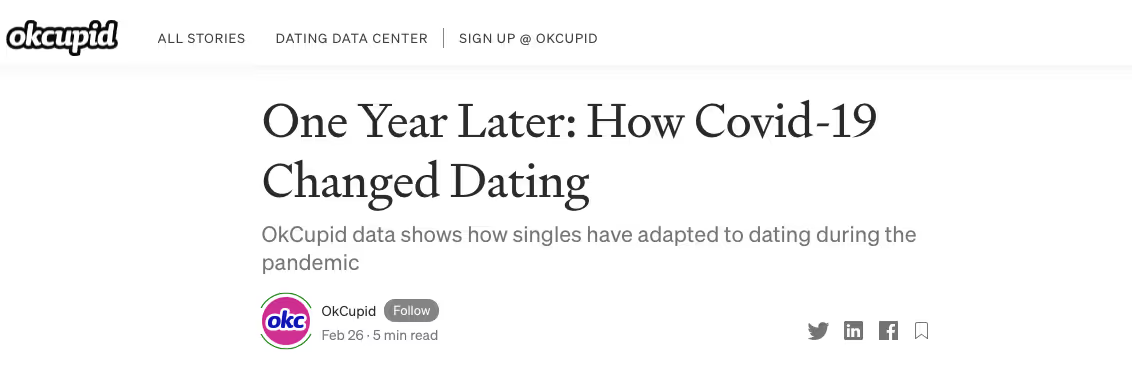
Example: LinkedIn
LinkedIn wrote about the most in-demand skills in 2020 and gave employers tips on how to get better candidates. The article was shared more than 19,000 times across Facebook.

No matter your industry, your data can be interesting. Look for ways to relate it to your audience.
Pinpoint the exact who and why behind sharing.
Two important questions to improve the odds of your content going viral:
- Who would most likely share it?
- Why would they share it?
The more specific your answer, the better. Understanding your audience is the core of virality—without people, content can’t be shared.
Why do people even share content in the first place? It’s a form of self-expression—how someone projects their identity.
The most relevant motivations include:
- Status: How does this content elevate the sharer’s status?
- Identity: How does this content reflect who the sharer is?
- Being helpful: Does this content benefit the sharer’s network?
- Novelty: What new, interesting, or entertaining idea does this content present?
Home in on the exact reason why a user might share your content. If you can’t pinpoint this why, your idea probably needs more refining.
Develop a compelling headline.
Content becomes viral because people decide it’s worthy of being shared. But half the battle of getting users to share content is getting them to click on it in the first place. That’s why headlines are a big deal for going viral—they impact whether users decide to read something on their newsfeed.
According to research on virality, the B2C headlines that are most likely to drive engagement:
- Stir emotion: “The Investment Advice That Could Change Your Financial Life”
- Create urgency: “These Popular Android Apps Are Putting User Data at Risk”
- Offer a solution or explanation: “Understanding Crypto: We Explain Bitcoin Lingo for Those Crypto Noobs”
- Use numbers: “The 50 Best TV Shows to Binge-Watch Tonight”
The top ecommerce headlines are:
- Stir emotion: “41 Cleaning Products So Effective You Might Want To Cry From Relief”
- Create urgency: “You’re Missing Out on Two Amazing Kitchen Gadgets”
- Offer a solution or explanation: “What is Kombucha? All Your Questions Answered”
- Use numbers: “12 Wardrobe Essentials For Every Woman”
While the top B2B headlines are:
- Explicitly describe what a piece of content is about: “62.41% of All Google Searches Generate 0 Clicks”
- Offer an explanation or actionable advice: “Ecommerce SEO: A Simple (But Complete) Guide”
- Relate to industry news: “How Intel and Burger King built an order recommendation system that preserves customer privacy”
- Use numbers: “18 Examples of Brilliant Email Marketing Campaigns”
- Include brackets for clarification: “Ecommerce Business Ideas in 2020 [27 Industry Experts]”
Consider why your audience should care about your content, and create a title based around this reason. Note that “compelling” doesn’t mean clickbait—avoid creating any titles that trick or mislead readers. You can test this by asking, “Would I be disappointed to see this piece of content based on the title?”
Optimize content for shareability.
If content can’t be shared easily, it probably won’t go viral.
To make content more shareable:
- Focus on a single message. Avoid tackling too many topics within one piece of content. Commit to one message; then get to the point quickly.
- Place social share buttons prominently so content is easier to share. Embed them above the fold (the part of a web page that’s immediately visible before scrolling); repeat them at the bottom of a post; or make them float alongside the content regardless of scrolling.
- Make content that’s easy to consume. Order your content logically and avoid using a lot of jargon. For text-based content, use headings, lists, and line breaks.
- Set a descriptive featured image for your content. Your content’s featured image is like a sneak peek of your content. Choose an appealing image to get more users to check it out.
Create content authentic to your brand identity.
Look at existing viral content for inspiration—but don’t try to copy it if it doesn’t fit your brand’s mission, voice, and values.
For example, some brands, like Netflix and Groupon, use humor successfully in their content to get virality. That doesn’t mean it’s a must for yours.
How to optimize your results
There may be trends in what makes some pieces of content go viral—but still, achieving virality is more art than science.
Part of why there’s no foolproof formula for virality is the fact that it usually reflects the culture and trends of a specific point in time—which are always changing. So a viral piece of content from 10 years ago might not go viral today because of changes in people’s ideas of what’s worth sharing.
Although there’s no easy answer to virality, you can increase its likelihood through repeated effort. Think of creativity as a muscle. To exercise it, you should:
- Monitor news and trending topics. Pay attention to news where your brand can make an interesting contribution.
- Study the latest viral content in your industry and from your competitors. Some great places to start: TLDR and Not Boring. Continue to reverse engineer the content that’s popular with your target audience, and look for ways to improve it.
- Experiment with your content. Test new approaches and ideas. Analyze your results, and apply new learnings to future pieces of content. For example, rewrite headlines and reshare your content at different times.
Examples of effective editorial/viral content
Zillow
The real estate marketplace Zillow has enough resources to invest in all kinds of content marketing, including creative content with the goal of getting lots of shares. For example, it’s created property listings for Santa’s home and the Incredibles’ super-home.
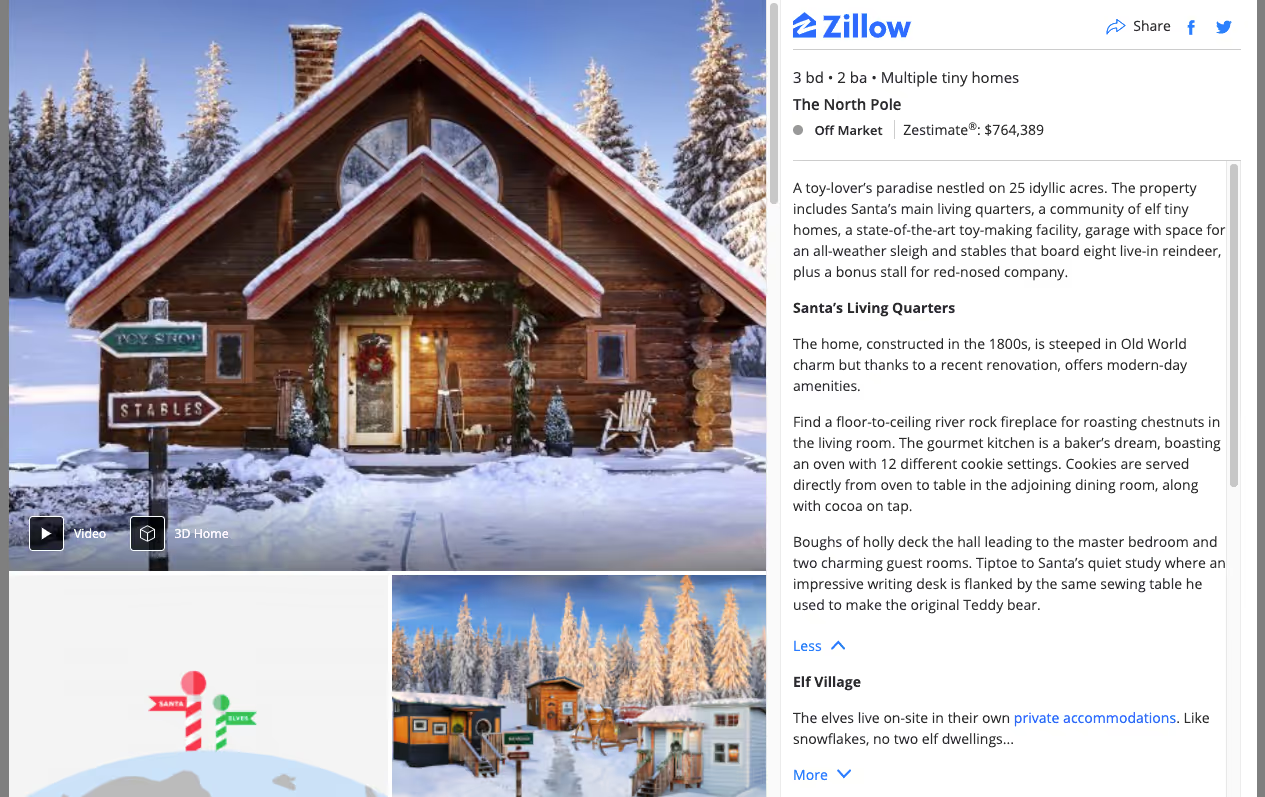

Zillow’s team even created press releases to get more eyes on these listings.
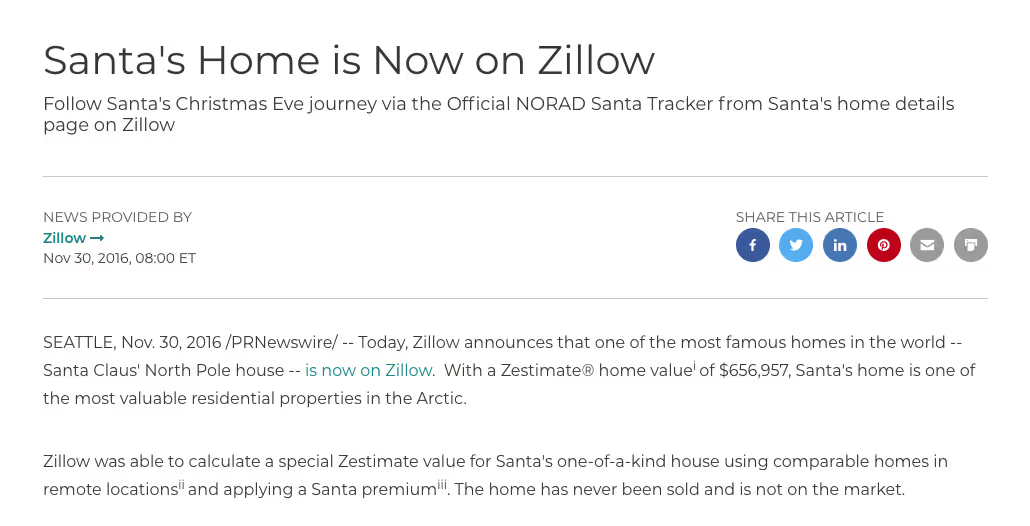
These fictional property listings aren’t meant to be optimized for SEO—they’re for entertainment. Anyone who likes Christmas or Pixar might share them for fun, placing Zillow’s brand in front of more people.
Course Hero
The online learning platform Course Hero commissions infographics as a key part of its content marketing strategy. There are more than 500 infographics, each of which summarizes a famous piece of literature.

Free for anyone to use, the infographics are especially useful for Course Hero’s target audience: teachers and students.
Because of their visual format, the infographics have been shared on Pinterest more than 253,000 times. Even better, they lead more new traffic to Course Hero’s website and other resources, like study guides for each famous book.
Beardbrand
The men’s grooming company Beardbrand is known for reinventing its market with its strong content marketing. It did this by taking a new angle on its target customers and creating fresh content to appeal to what it called the “urban beardsman”—not the hippies, lumberjacks, or other stereotypes often associated with beards.
You can find this content on Beardbrand’s YouTube channel, which has more than 1.7 million subscribers. Some of its most popular videos are hair and beard transformations, which receive millions of views and thousands of comments.
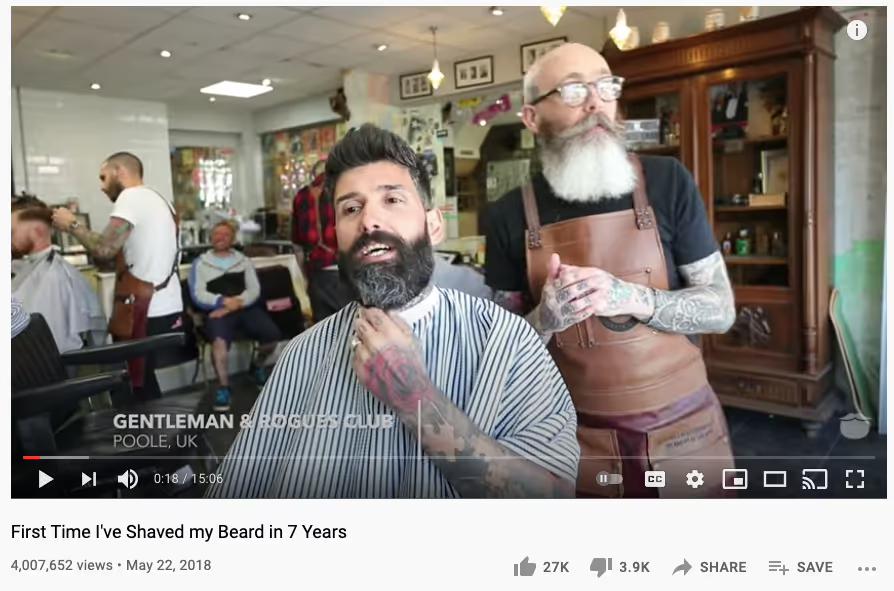
The videos aren’t optimized for popular keywords—instead, they’re meant to be entertaining and grab the attention of those who fit Beardbrand’s target audience.
BARK
BARK, the company behind dog-themed subscription service BarkBox, focuses on creating viral content to appeal to dog owners.
Early on, its writers focused mostly on targeting keywords to create educational content—topics like “how to trim your dog’s toenails.” But noticing that few other pet brands were being silly at the time, the team decided to take a more personable approach to content.
So they created the content site BarkPost, which publishes mostly entertaining articles about dogs. Take a look at some of its slideshow titles.
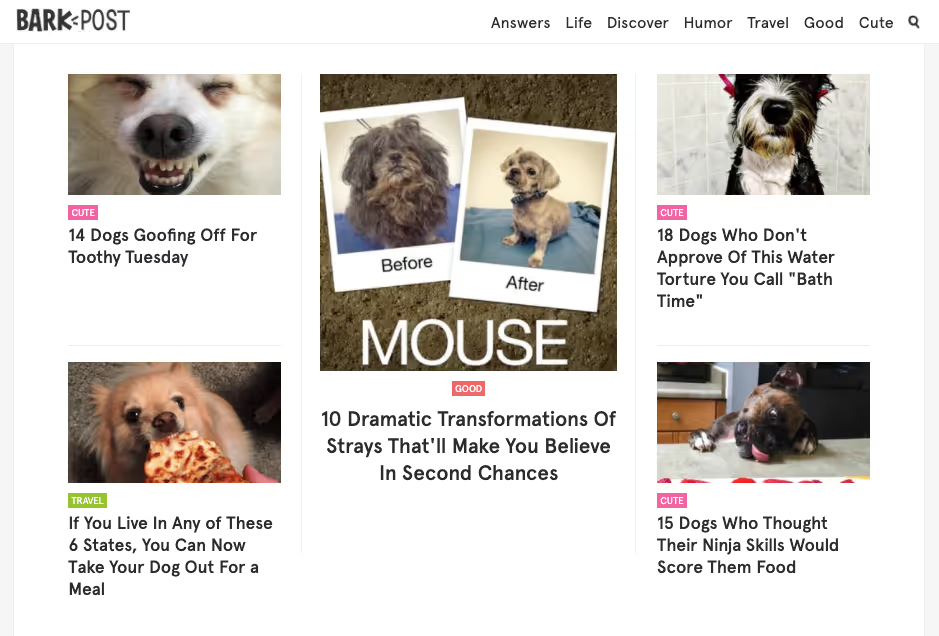
Finding humor in everyday dog antics is something that many dog owners can relate to—and something that they’d find shareworthy. Many of BarkPost’s articles regularly get thousands of shares on Facebook, Pinterest, and other social media networks, as well as mentions and links from major media outlets like HuffPost, USA Today, and PBS.
Priceonomics’ blog
Priceonomics started out as a price guide for buying and selling used items, but over time, became known for its viral blog posts. On average, its blog posts each get 25,000 views. Here are the titles of a few of the most popular:
- “Diamonds Are Bullshit”
- “What It's Like to Fail”
- “The San Francisco Rent Explosion”
- “How Photography Was Optimized for White Skin Color”
Priceonomics’ content writers don’t care about whether their blog posts rank #1 in search results. Instead, they want to create content that people find interesting and worth sharing—which is why their blog post titles are written in such an intriguing way.
Priceonomics’ posts don't go viral just because of their title, though. The writers optimize content for shareability by:
- Leveraging data for a compelling story
- Honing in on one message or idea per post
- Making content easily digestible, e.g., writing concisely and including graphs and other visuals to support content
- Organizing information logically
- Extensive editing and rewriting
Mailchimp’s “Did You Mean Mailchimp?” campaign
A few years ago, email marketing platform Mailchimp partnered with an advertising agency to create nine mini marketing campaigns for things that rhymed with its brand name, including:
- MailShrimp, JailBlimp, KaleLimp: surreal short films that screened in theaters
- FailChips: bags of pre-crushed potato chips
- NailChamp: an online competition for nail artists
- SnailPrimp: an anti-aging beauty treatment
The goal: drive awareness of Mailchimp’s brand among small to medium-sized businesses across various niches.
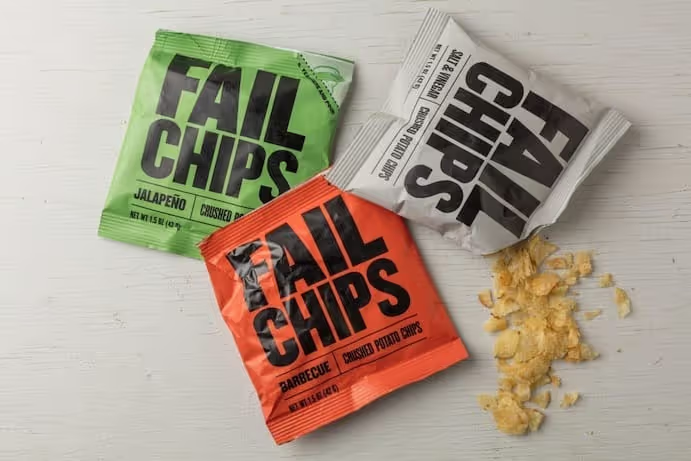
The campaigns had little in common, but they were each designed to get attention—and they worked. Media outlets like RollingStone, BuzzFeed, and PopSugar covered them; then, when anyone turned to Google to look up one of the campaigns, they’d land on Mailchimp.
In the end, the whole campaign generated 988 million earned media impressions and 67 million organic searches.


